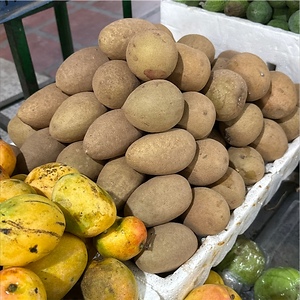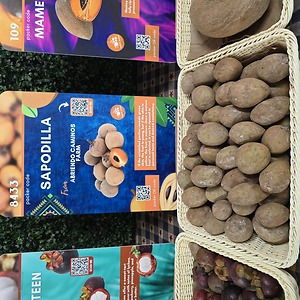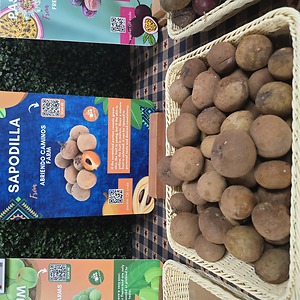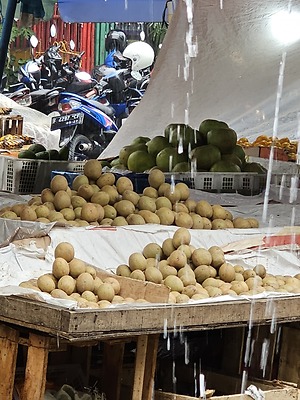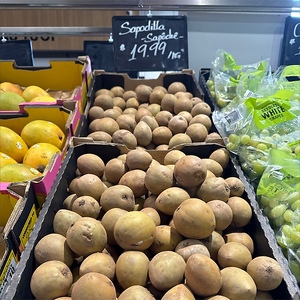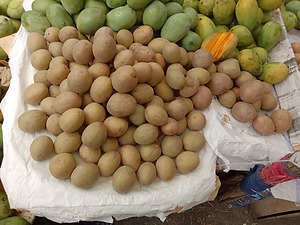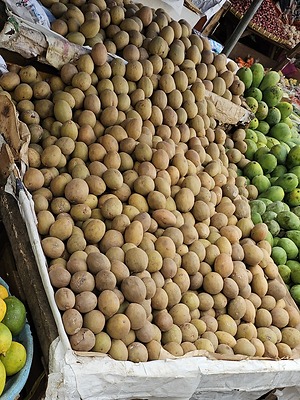

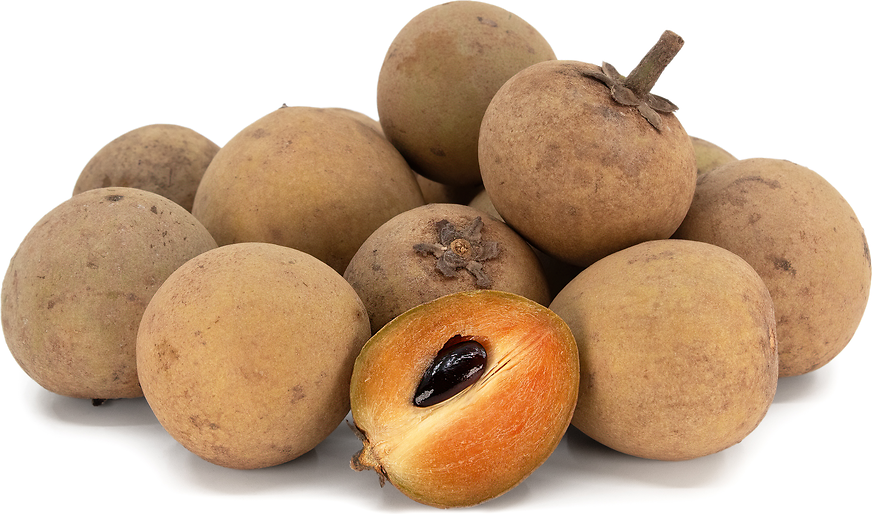
Sapodilla
Estimated Inventory, lb : 0
This item was last sold on : 06/01/25
Description/Taste
Sapodillas are generally small, averaging 4 to 12 centimeters in length, and vary in shape from oval, conical, round, to oblate, depending on the specific variety. The skin is thin, semi-smooth, and tan to light brown, sometimes covered in a rough, textured coating that dissipates as it ripens. Underneath the surface, the flesh is firm, dense, and astringent when young, containing a high saponin content causing the sensation of cotton mouth if consumed. The fruits must be ripe before eating, and as the fruit matures, the yellow-orange to red-brown flesh will soften and develop an aqueous, pulpy texture. The flesh will also contain a granular, somewhat grainy consistency and encase 3 to 12 glossy, oval, and hard, black-brown seeds in a central cavity. The seeds are inedible and should not be consumed as each seed bears a small hook on one end that can catch in the soft tissue of the throat. Sapodillas have a faint squash-like scent when sliced open, and the flesh is sweet, musky, and malty with molasses, pear, and brown sugar nuances. When selecting Sapodillas, the skin should be lightly scratched. If the scratched portion reveals green skin, the fruit is young, but if the skin is yellow, the fruit is mature. Once a mature fruit is selected, it can be ripened to personal taste and desired consistency.
Seasons/Availability
Sapodillas are available year-round. The fruits are grown worldwide, and the peak fruiting season will vary depending on the region and climate.
Current Facts
Sapodillas, botanically classified as Manilkara zapota, are sweet, tropical fruits that grow on large trees that reach up to 30 meters in height, belonging to the Sapotaceae family. The ancient trees are native to forests of Mexico and Central America and have been cultivated for thousands of years for their fruits and white, sticky sap. With their extensive history, many Sapodilla varieties have been created over time, varying slightly in appearance, shape, and flavor. The fruits were also spread around the world through explorers and colonists, contributing to the diverse variation in cultivars. Sapodilla fruits are known by many names worldwide, including Chikoo, Zapotillo, Sapota, Naseberry, Sepadilla, and Zapote. When ripe, Sapodillas are considered a luxury fruit that is primarily consumed fresh to savor the flesh’s warm, malty flavor. The fruits have also been traditionally consumed in beverages among civilizations as a nutritious source of vitamins and minerals.
Nutritional Value
Sapodillas are an excellent source of fiber to stimulate the digestive tract and act as a natural cleanser for the body. The fruits are also rich in vitamin C to strengthen the immune system, provide some vitamin A to protect against vision loss, and contain lower amounts of iron, copper, and potassium. In addition to vitamins and minerals, Sapodillas are a source of tannins, which are compounds known as polyphenols that have anti-bacterial and anti-inflammatory properties.
Applications
Sapodillas have a unique sugary and malty flavor and soft, grainy texture showcased when consumed straight, out-of-hand, chilled or at room temperature. The fruits can be sliced in half, and the flesh scooped with a spoon, discarding the seeds. Sapodilla seeds should not be consumed as they bear a small hook-like protrusion that can catch and become stuck in the throat. The raw flesh can be mixed into fruit bowls, tossed into green salads, or blended into smoothies and milkshakes. It can also be pureed and strained into sauces or churned into ice cream. In addition to fresh preparations, Sapodillas can be simmered into jams and syrups, fried as a simple dessert, mashed into muffin, cake, and pancake batters, or stewed with lime juice. The fruits can also be incorporated into custards and puddings or baked into tarts and pies. Sapodillas pair well with fruits such as bananas, passion fruit, oranges, and limes, spices such as cinnamon, nutmeg, ginger, and cloves, cacao powder, vanilla, honey, brown sugar, and whipped cream. It is important to note that the fruits are harvested from the tree when they are mature but not ripe for eating. Once the fruits are picked mature, they should be kept for 7 to 10 days at room temperature to allow the starches in the flesh to convert into sugars. The flesh will soften after the ripening period, and once ready, the fruits can be consumed immediately or stored for a couple of days in the refrigerator. Sapodillas can also be frozen, but the texture of the flesh will be altered. Frozen Sapodillas are best used for smoothies, sauces, ice cream, and other blended applications.
Ethnic/Cultural Info
In Mexico, Sapodilla trees are famously known for chicle, a thick, sticky white sap that was a natural, protective barrier used by the trees to seal cuts and cracks within the trunk and branches. In ancient times, Mayan and Aztec civilizations discovered that the sap could be boiled, molded into blocks, and sliced into small pieces to create a chewable substance to clean teeth and freshen breath. Chicle was also used to curve hunger pains and was primarily chewed in secret, as the civilizations had strict rules on chewing in public. Aztecs deemed chewing chicle in public taboo, only allowing children, prostitutes, and older single women to chew around other civilians. Throughout history, Sapodilla trees continued to be harvested for their sap, and chicleros, men who would extract the sap from the trees, lived in the forests, protecting their commandeered trees with a unique marking. In 1866, chicle was introduced to an American businessman, Thomas Adams, sparking the American chewing gum revolution. Adams mixed chicle with sugar and other flavorings to create a chewing gum and imported chicle from Central America and Mexico for mass production and sales. Chicle was used in chewing gum for many years, but during World War II, chicle imports were stretched thin as the military used gum as part of the soldier’s rations. Many Sapodilla trees were over-extracted, killing the trees, and American chewing gum companies looked to other alternatives, eventually switching to synthetic materials in the mid-1900s. In the present day, older Sapodilla trees can still be seen with chicleros lacerations and markings in Mexico's forests, and there is a small but growing resurgence for natural chewing gums made from chicle.
Geography/History
Sapodilla trees are native to tropical regions of Southern Mexico, Northwestern Guatemala, and Northern Belize and have been growing wild since ancient times. The evergreen trees spread across Central America in the early ages through human cultivation, animal feces, and natural propagation and were also introduced into the Caribbean, Florida Keys, and regions of South America. Sapodilla was brought to the Philippines sometime in the 17th century and was planted throughout Southeast Asia in the 18th and 19th centuries. Today Sapodilla trees are commercially cultivated in Mexico, India, Guatemala, and the Philippines and are also grown in Malaysia, Indonesia, Vietnam, Thailand, Cambodia, Pakistan, Bangladesh, Central and South America, Australia, South Africa, and in Florida of the United States.
Recipe Ideas
Recipes that include Sapodilla. One
| Cooking Sense |
|
Sapodilla Crumble |



